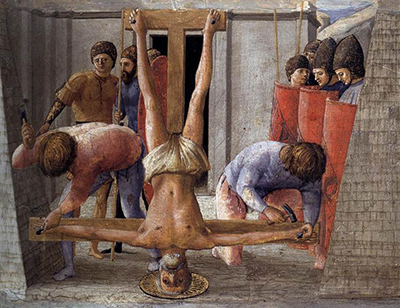The crucifixion of St. Peter by the early renaissance artist Masaccio illuminates a timeless style used to depict an array of stories.
The painting belongs to a series of periled panels located in the Pisa church as a altarpiece. The artist was commissioned to paint a series of artwork for the church in order to manifest the Roman Catholic religion.
Masaccio faced a difficulty with the artwork, as he did not with for the crucifixion for St. Peter to be mistaken with the crucifixion of Jesus Christ. Therefor the artist had showcased the body hung from the legs in order for the viewer to distinguish the two deaths.
The artwork dates back to 1426 and showcases MasaccioÕs impeccable talent and commitment to painting murals for the church. These artworks were incredibly prominent during the renaissance era as they were able to depict biblical stories through a visual representation and decorated the walls of the churches.
Masaccio illustrated the crucifixion of St. Peter as he rotates his body upside within the mural as background figures nail him to the cross. The artist did not fully paint the cross as he did in his other artwork, Crucifixion, creating a distinction between the two holy figures. St. Peter is strung upside down, almost in an insulting form as his death falls upon a brutal end.
The artist moved away from his classic golden bright shades that he often used when portraying biblical scenes to faded colours based in grey. This change in colour manifests a different emotion in the work as the artwork solemnly depicts as the dark scene.
The death of St. Peter does not hold the romanticized presence that the crucifixion of Chris does. The death of Christ showcases the father of the religion sacrificing his self in order to relieve the sins of his people, rather than the brutal death of St. Peter seized for his beliefs and proclamations.
The artist continued in the realist renaissance technique throughout the art piece. Using soft swift movements to accentuate detail and form within the artwork. Yet, the artist blurs the exact detail showcased within the painting as the muted colours up rise a different feel in the mural placed on the chapel.
Two male figures nail down the hands of the Saint as blood drops down the left side of his body. Three men near the right side of the artwork stand behind bright orange coloured textiles as they shook the brutal scene. The Artie was incredibly masterful in his use of colour, as he understood the different emotions each colour upraised. Masaccio carried an impeccable understanding of the way in which different colours are paired with one another.
The grey concrete illustrated on the floor and walls of the painting is the exact texture in which a cooler feel to the artwork uproars. The artist intertwined sharp shades of orange to the right of the painting to add life, however cooler shades stand as the focal point of the painting.




